IMAT 5209 - Human Factor in System Design: Usability Evaluation
VerifiedAdded on 2023/06/08
|21
|5824
|341
Report
AI Summary
This report focuses on the human factor in system design, specifically addressing the usability evaluation of interactive systems. It begins by defining interactive systems and their users, emphasizing the importance of user interaction and interface design. The report then explores various usability evaluation methodologies, including usability testing, expert reviews, and the application of ISO standards. A detailed description of an evaluation procedure is provided, highlighting the importance of qualitative and quantitative data collection. The report also covers the collection of evidence regarding system usability, with a focus on e-commerce systems. The findings of the usability evaluation are presented, along with recommendations for system improvement. The report concludes by emphasizing the significance of user-centered design and the application of international standards to ensure system effectiveness, efficiency, and user satisfaction. The report also discusses different approaches for examining design details, comparing different approaches and standards such as ISO/IEC 14958, ISO 9241, ISO 13407, and ISO 18529 and CH MiLE methodology. The report covers different aspects of usability such as content, navigation, performance and interface design.

Running head: HUMAN FACTOR IN SYSTEM DESIGN
Human Factor in System Design
Name of the Student
Name of the University
Author’s Note
Human Factor in System Design
Name of the Student
Name of the University
Author’s Note
Paraphrase This Document
Need a fresh take? Get an instant paraphrase of this document with our AI Paraphraser
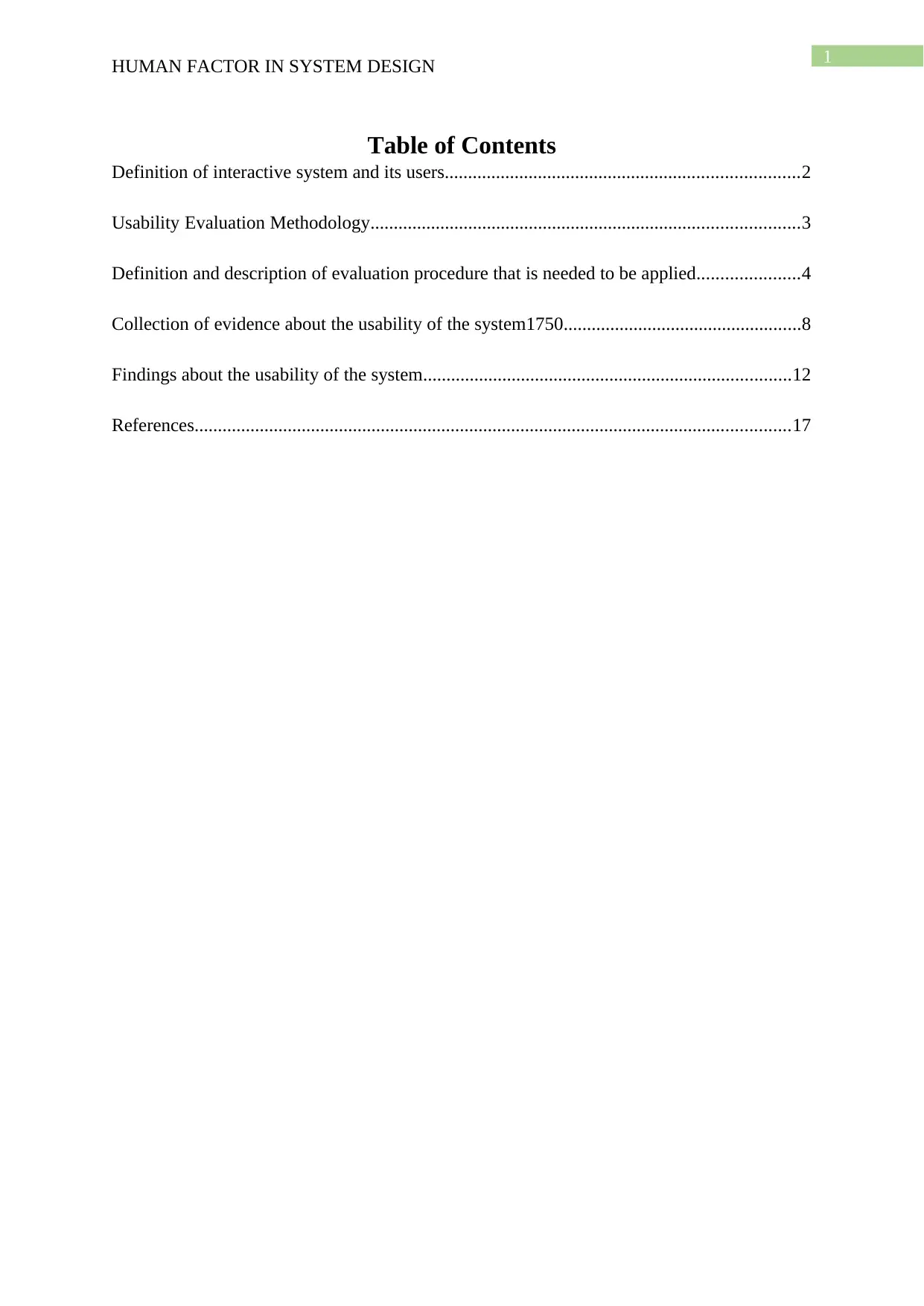
1
HUMAN FACTOR IN SYSTEM DESIGN
Table of Contents
Definition of interactive system and its users............................................................................2
Usability Evaluation Methodology............................................................................................3
Definition and description of evaluation procedure that is needed to be applied......................4
Collection of evidence about the usability of the system1750...................................................8
Findings about the usability of the system...............................................................................12
References................................................................................................................................17
HUMAN FACTOR IN SYSTEM DESIGN
Table of Contents
Definition of interactive system and its users............................................................................2
Usability Evaluation Methodology............................................................................................3
Definition and description of evaluation procedure that is needed to be applied......................4
Collection of evidence about the usability of the system1750...................................................8
Findings about the usability of the system...............................................................................12
References................................................................................................................................17

2
HUMAN FACTOR IN SYSTEM DESIGN
Definition of interactive system and its users
The interactive system is defined as the computer system that have a significant
interaction between the computers and the humans. As an example of graphical interactive
system are the operation system that are installed in the computers. The application software
such as CAD, data entry systems, simulation software requires high level interaction of the
user with the system. The IDEs and the web browsers can also be considered as an example
of the interaction system (Preece, Rogers and Sharp 2015). About 90 percent of the effort in
development of the technology is given on enhancing the interface and improve the
interaction of the user with the developed system.
The preference of the people and the feature that can attract more number of people
should be understood for the development of the interface of the system. There is a need to
analyse the needs of the user for the development of the interface and align the interface with
the developed system. The construction of the unambiguous icons needs to understand and
the common errors that are the part of the usability of the system should also be identified for
the development of an interactive system (Card 2017). Previously command line interface
was used as an interactive system that have a controlled interaction between the computer and
the user. In the command line interface the user using the system needs efficient knowledge
about the commands or the arguments for getting the desired output. The data is needed to be
inputted in the system in a sequential manner. There was a limitation for getting the output
but currently there is a development with the generation of agents and the virtual system and
different types of system such as direct manipulation system and embedded systems has been
developed for the improvement of the interaction and get the maximum output from the
system (Lazar, Feng and Hochheiser 2017).
HUMAN FACTOR IN SYSTEM DESIGN
Definition of interactive system and its users
The interactive system is defined as the computer system that have a significant
interaction between the computers and the humans. As an example of graphical interactive
system are the operation system that are installed in the computers. The application software
such as CAD, data entry systems, simulation software requires high level interaction of the
user with the system. The IDEs and the web browsers can also be considered as an example
of the interaction system (Preece, Rogers and Sharp 2015). About 90 percent of the effort in
development of the technology is given on enhancing the interface and improve the
interaction of the user with the developed system.
The preference of the people and the feature that can attract more number of people
should be understood for the development of the interface of the system. There is a need to
analyse the needs of the user for the development of the interface and align the interface with
the developed system. The construction of the unambiguous icons needs to understand and
the common errors that are the part of the usability of the system should also be identified for
the development of an interactive system (Card 2017). Previously command line interface
was used as an interactive system that have a controlled interaction between the computer and
the user. In the command line interface the user using the system needs efficient knowledge
about the commands or the arguments for getting the desired output. The data is needed to be
inputted in the system in a sequential manner. There was a limitation for getting the output
but currently there is a development with the generation of agents and the virtual system and
different types of system such as direct manipulation system and embedded systems has been
developed for the improvement of the interaction and get the maximum output from the
system (Lazar, Feng and Hochheiser 2017).
⊘ This is a preview!⊘
Do you want full access?
Subscribe today to unlock all pages.

Trusted by 1+ million students worldwide

3
HUMAN FACTOR IN SYSTEM DESIGN
Usability Evaluation Methodology
For the evaluation of the usability of a system information should be gathered using
different types of methodology for gathering user feedback about the website created or the
site that is planned to create. There are different usability evaluation methodology that can be
applied and are given below:
Usability test result reporting – The results of the usability testing should be prepared
by focusing on the recommendation and findings that can be differentiated with the severity
level (Grenha Teixeira et al. 2017). The pertinent information obtained from the test planning
should be enough for methodology.
Test participant recruitment – Participants should be recruited those are expected to
use the website or have precious experience of using similar type of sites. The participants
should be dependent on the product or the site and there can be a multiple potential groups or
users (Roedl, Odom and Blevis 2018). Each of the group should have representatives for
optimizing the test performance.
Usability test planning – It is one of the essential factor and a test plan is needed to be
created for proceeding with the testing.
First click test – In this test the components of the interface that is clicked first by the
user for the completion of the intended task. For proceeding with the testing a prototype of
the website, wireframe or the functional website can be used.
System usability scale – It is considered as a reliable tool that measures the usability
and it mainly consists of a set of 10 questions in the questionnaires. Five response is taken
from the users with the different options that ranges from strongly agree to strongly disagree.
HUMAN FACTOR IN SYSTEM DESIGN
Usability Evaluation Methodology
For the evaluation of the usability of a system information should be gathered using
different types of methodology for gathering user feedback about the website created or the
site that is planned to create. There are different usability evaluation methodology that can be
applied and are given below:
Usability test result reporting – The results of the usability testing should be prepared
by focusing on the recommendation and findings that can be differentiated with the severity
level (Grenha Teixeira et al. 2017). The pertinent information obtained from the test planning
should be enough for methodology.
Test participant recruitment – Participants should be recruited those are expected to
use the website or have precious experience of using similar type of sites. The participants
should be dependent on the product or the site and there can be a multiple potential groups or
users (Roedl, Odom and Blevis 2018). Each of the group should have representatives for
optimizing the test performance.
Usability test planning – It is one of the essential factor and a test plan is needed to be
created for proceeding with the testing.
First click test – In this test the components of the interface that is clicked first by the
user for the completion of the intended task. For proceeding with the testing a prototype of
the website, wireframe or the functional website can be used.
System usability scale – It is considered as a reliable tool that measures the usability
and it mainly consists of a set of 10 questions in the questionnaires. Five response is taken
from the users with the different options that ranges from strongly agree to strongly disagree.
Paraphrase This Document
Need a fresh take? Get an instant paraphrase of this document with our AI Paraphraser
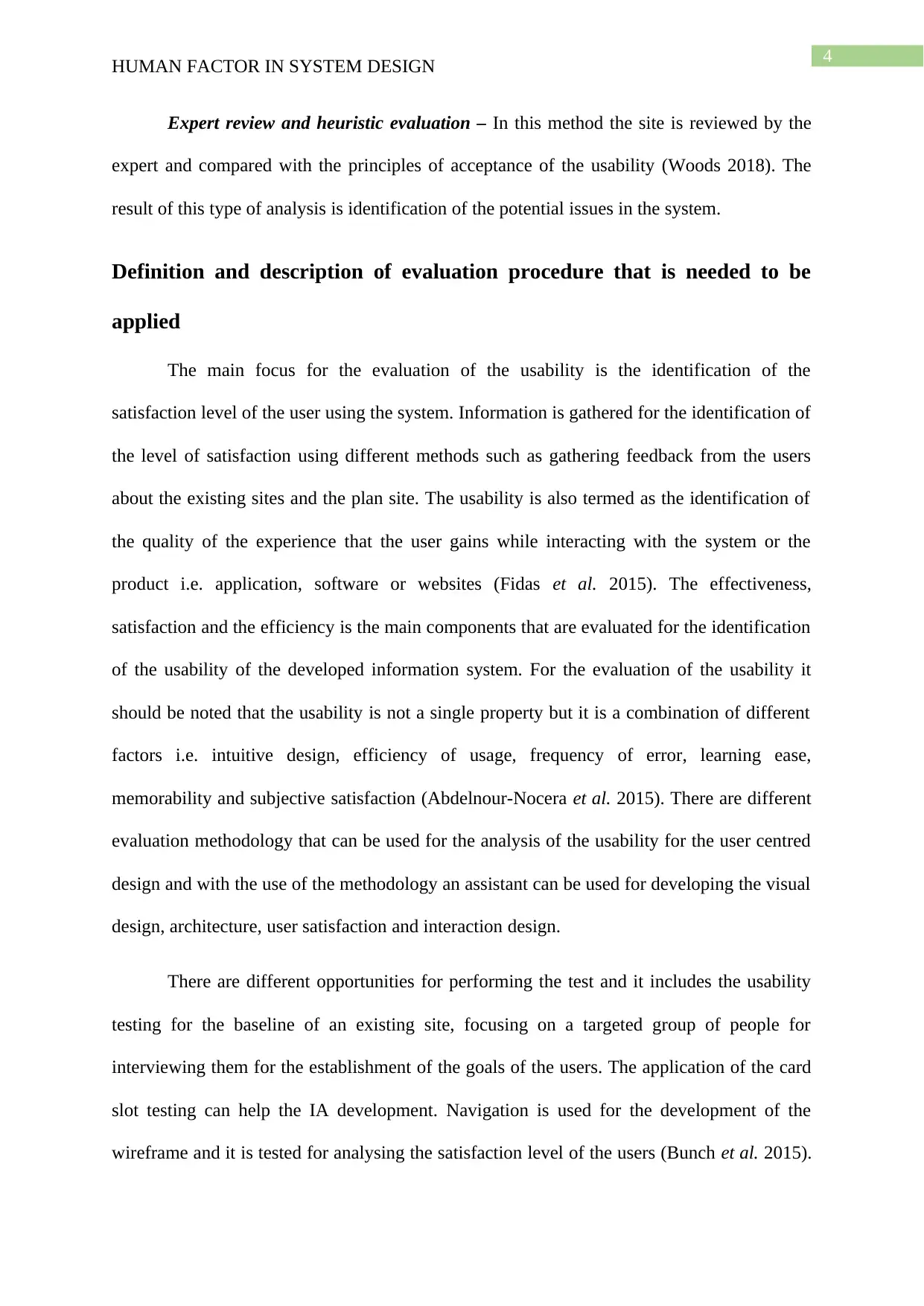
4
HUMAN FACTOR IN SYSTEM DESIGN
Expert review and heuristic evaluation – In this method the site is reviewed by the
expert and compared with the principles of acceptance of the usability (Woods 2018). The
result of this type of analysis is identification of the potential issues in the system.
Definition and description of evaluation procedure that is needed to be
applied
The main focus for the evaluation of the usability is the identification of the
satisfaction level of the user using the system. Information is gathered for the identification of
the level of satisfaction using different methods such as gathering feedback from the users
about the existing sites and the plan site. The usability is also termed as the identification of
the quality of the experience that the user gains while interacting with the system or the
product i.e. application, software or websites (Fidas et al. 2015). The effectiveness,
satisfaction and the efficiency is the main components that are evaluated for the identification
of the usability of the developed information system. For the evaluation of the usability it
should be noted that the usability is not a single property but it is a combination of different
factors i.e. intuitive design, efficiency of usage, frequency of error, learning ease,
memorability and subjective satisfaction (Abdelnour-Nocera et al. 2015). There are different
evaluation methodology that can be used for the analysis of the usability for the user centred
design and with the use of the methodology an assistant can be used for developing the visual
design, architecture, user satisfaction and interaction design.
There are different opportunities for performing the test and it includes the usability
testing for the baseline of an existing site, focusing on a targeted group of people for
interviewing them for the establishment of the goals of the users. The application of the card
slot testing can help the IA development. Navigation is used for the development of the
wireframe and it is tested for analysing the satisfaction level of the users (Bunch et al. 2015).
HUMAN FACTOR IN SYSTEM DESIGN
Expert review and heuristic evaluation – In this method the site is reviewed by the
expert and compared with the principles of acceptance of the usability (Woods 2018). The
result of this type of analysis is identification of the potential issues in the system.
Definition and description of evaluation procedure that is needed to be
applied
The main focus for the evaluation of the usability is the identification of the
satisfaction level of the user using the system. Information is gathered for the identification of
the level of satisfaction using different methods such as gathering feedback from the users
about the existing sites and the plan site. The usability is also termed as the identification of
the quality of the experience that the user gains while interacting with the system or the
product i.e. application, software or websites (Fidas et al. 2015). The effectiveness,
satisfaction and the efficiency is the main components that are evaluated for the identification
of the usability of the developed information system. For the evaluation of the usability it
should be noted that the usability is not a single property but it is a combination of different
factors i.e. intuitive design, efficiency of usage, frequency of error, learning ease,
memorability and subjective satisfaction (Abdelnour-Nocera et al. 2015). There are different
evaluation methodology that can be used for the analysis of the usability for the user centred
design and with the use of the methodology an assistant can be used for developing the visual
design, architecture, user satisfaction and interaction design.
There are different opportunities for performing the test and it includes the usability
testing for the baseline of an existing site, focusing on a targeted group of people for
interviewing them for the establishment of the goals of the users. The application of the card
slot testing can help the IA development. Navigation is used for the development of the
wireframe and it is tested for analysing the satisfaction level of the users (Bunch et al. 2015).
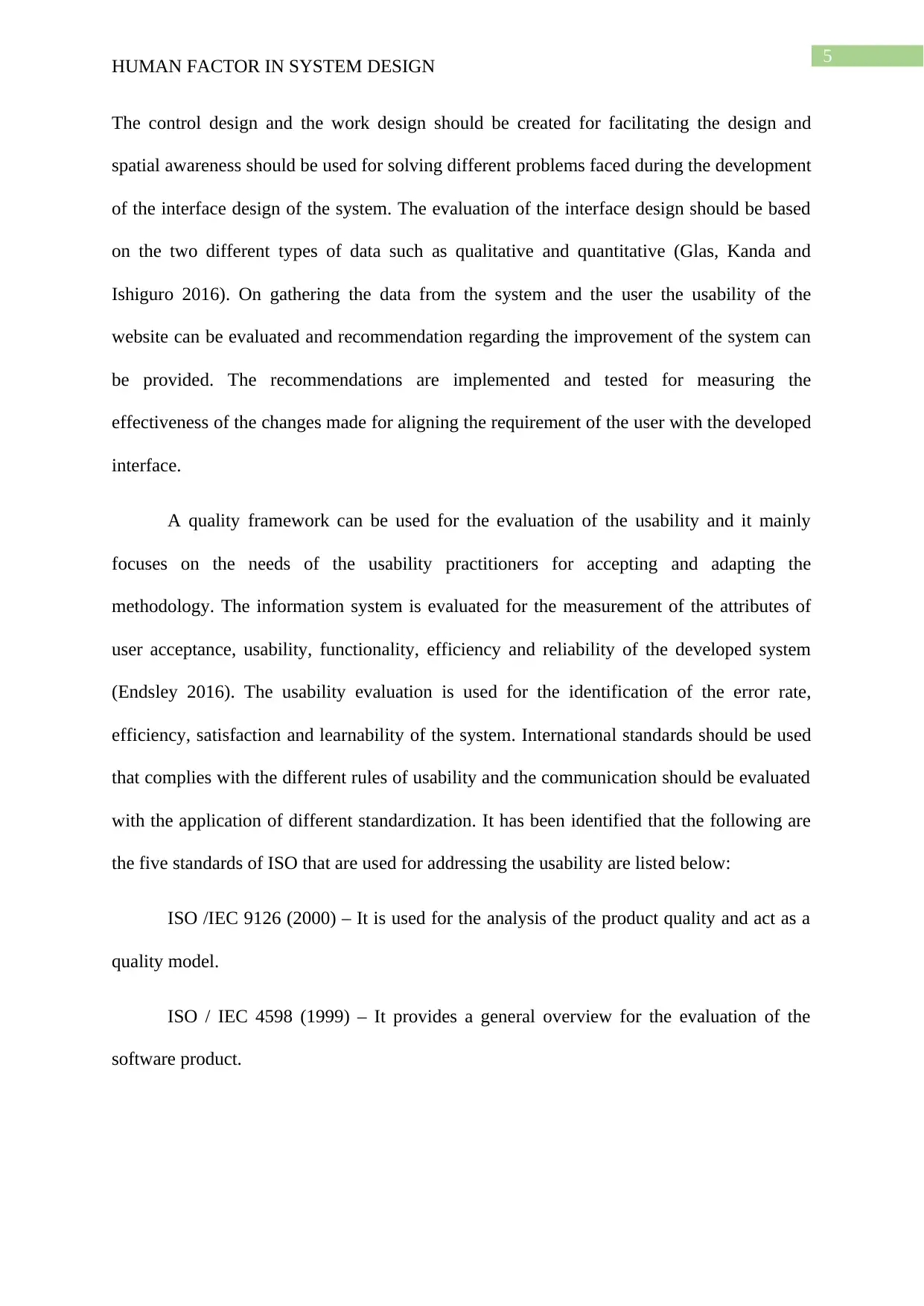
5
HUMAN FACTOR IN SYSTEM DESIGN
The control design and the work design should be created for facilitating the design and
spatial awareness should be used for solving different problems faced during the development
of the interface design of the system. The evaluation of the interface design should be based
on the two different types of data such as qualitative and quantitative (Glas, Kanda and
Ishiguro 2016). On gathering the data from the system and the user the usability of the
website can be evaluated and recommendation regarding the improvement of the system can
be provided. The recommendations are implemented and tested for measuring the
effectiveness of the changes made for aligning the requirement of the user with the developed
interface.
A quality framework can be used for the evaluation of the usability and it mainly
focuses on the needs of the usability practitioners for accepting and adapting the
methodology. The information system is evaluated for the measurement of the attributes of
user acceptance, usability, functionality, efficiency and reliability of the developed system
(Endsley 2016). The usability evaluation is used for the identification of the error rate,
efficiency, satisfaction and learnability of the system. International standards should be used
that complies with the different rules of usability and the communication should be evaluated
with the application of different standardization. It has been identified that the following are
the five standards of ISO that are used for addressing the usability are listed below:
ISO /IEC 9126 (2000) – It is used for the analysis of the product quality and act as a
quality model.
ISO / IEC 4598 (1999) – It provides a general overview for the evaluation of the
software product.
HUMAN FACTOR IN SYSTEM DESIGN
The control design and the work design should be created for facilitating the design and
spatial awareness should be used for solving different problems faced during the development
of the interface design of the system. The evaluation of the interface design should be based
on the two different types of data such as qualitative and quantitative (Glas, Kanda and
Ishiguro 2016). On gathering the data from the system and the user the usability of the
website can be evaluated and recommendation regarding the improvement of the system can
be provided. The recommendations are implemented and tested for measuring the
effectiveness of the changes made for aligning the requirement of the user with the developed
interface.
A quality framework can be used for the evaluation of the usability and it mainly
focuses on the needs of the usability practitioners for accepting and adapting the
methodology. The information system is evaluated for the measurement of the attributes of
user acceptance, usability, functionality, efficiency and reliability of the developed system
(Endsley 2016). The usability evaluation is used for the identification of the error rate,
efficiency, satisfaction and learnability of the system. International standards should be used
that complies with the different rules of usability and the communication should be evaluated
with the application of different standardization. It has been identified that the following are
the five standards of ISO that are used for addressing the usability are listed below:
ISO /IEC 9126 (2000) – It is used for the analysis of the product quality and act as a
quality model.
ISO / IEC 4598 (1999) – It provides a general overview for the evaluation of the
software product.
⊘ This is a preview!⊘
Do you want full access?
Subscribe today to unlock all pages.

Trusted by 1+ million students worldwide

6
HUMAN FACTOR IN SYSTEM DESIGN
ISO 9241 (1998) – It provide a guide for the usability and manages the ergonomic
requirement for the management of the office work with the application of visual display
terminal.
ISO 13407 (1999) It is used for the management of the human centred interactive
system design
ISO 18529 (2000) – It is used for providing a description of the human centred life
cycle and identification of the Ergonomics.
The scopes of the application of the international standards should also be analysed
for the identification of the elements and such as;
The entity under the evaluation
Stakeholders for addressing the standard
Different phases of the life cycle.
Different approaches can be used for examining the details and the guidelines and by
comparing the different approaches the following observation is made.
ISO /IEC 14958 is used for providing a general process for the management of the
quality of the software product. The different phases involved for the development of the
project should be well defined and a project plan should be created for the identification of
the input and output of each of the activity (Höök et al. 2015). Different quality models
should be used and it should be specified for reaching to the final stage of the product.
ISO 9241 is used for distinguishing the interface during the evaluation and the design
phase of project.
ISO 13407 is used for addressing the issues in the design and maintain a long term
monitoring of the design comparing it with the human centred design (Mast et al. 2015). The
HUMAN FACTOR IN SYSTEM DESIGN
ISO 9241 (1998) – It provide a guide for the usability and manages the ergonomic
requirement for the management of the office work with the application of visual display
terminal.
ISO 13407 (1999) It is used for the management of the human centred interactive
system design
ISO 18529 (2000) – It is used for providing a description of the human centred life
cycle and identification of the Ergonomics.
The scopes of the application of the international standards should also be analysed
for the identification of the elements and such as;
The entity under the evaluation
Stakeholders for addressing the standard
Different phases of the life cycle.
Different approaches can be used for examining the details and the guidelines and by
comparing the different approaches the following observation is made.
ISO /IEC 14958 is used for providing a general process for the management of the
quality of the software product. The different phases involved for the development of the
project should be well defined and a project plan should be created for the identification of
the input and output of each of the activity (Höök et al. 2015). Different quality models
should be used and it should be specified for reaching to the final stage of the product.
ISO 9241 is used for distinguishing the interface during the evaluation and the design
phase of project.
ISO 13407 is used for addressing the issues in the design and maintain a long term
monitoring of the design comparing it with the human centred design (Mast et al. 2015). The
Paraphrase This Document
Need a fresh take? Get an instant paraphrase of this document with our AI Paraphraser
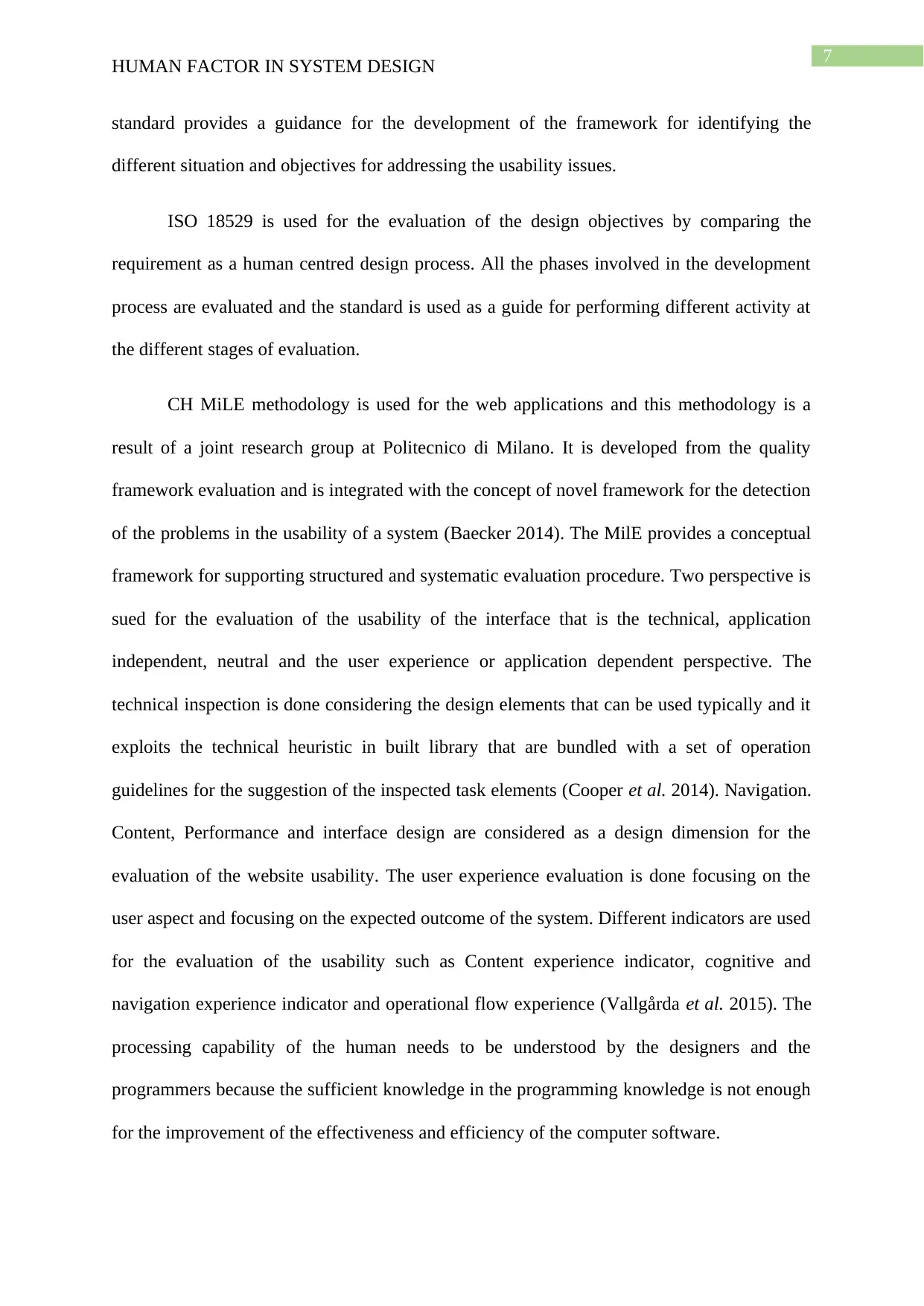
7
HUMAN FACTOR IN SYSTEM DESIGN
standard provides a guidance for the development of the framework for identifying the
different situation and objectives for addressing the usability issues.
ISO 18529 is used for the evaluation of the design objectives by comparing the
requirement as a human centred design process. All the phases involved in the development
process are evaluated and the standard is used as a guide for performing different activity at
the different stages of evaluation.
CH MiLE methodology is used for the web applications and this methodology is a
result of a joint research group at Politecnico di Milano. It is developed from the quality
framework evaluation and is integrated with the concept of novel framework for the detection
of the problems in the usability of a system (Baecker 2014). The MilE provides a conceptual
framework for supporting structured and systematic evaluation procedure. Two perspective is
sued for the evaluation of the usability of the interface that is the technical, application
independent, neutral and the user experience or application dependent perspective. The
technical inspection is done considering the design elements that can be used typically and it
exploits the technical heuristic in built library that are bundled with a set of operation
guidelines for the suggestion of the inspected task elements (Cooper et al. 2014). Navigation.
Content, Performance and interface design are considered as a design dimension for the
evaluation of the website usability. The user experience evaluation is done focusing on the
user aspect and focusing on the expected outcome of the system. Different indicators are used
for the evaluation of the usability such as Content experience indicator, cognitive and
navigation experience indicator and operational flow experience (Vallgårda et al. 2015). The
processing capability of the human needs to be understood by the designers and the
programmers because the sufficient knowledge in the programming knowledge is not enough
for the improvement of the effectiveness and efficiency of the computer software.
HUMAN FACTOR IN SYSTEM DESIGN
standard provides a guidance for the development of the framework for identifying the
different situation and objectives for addressing the usability issues.
ISO 18529 is used for the evaluation of the design objectives by comparing the
requirement as a human centred design process. All the phases involved in the development
process are evaluated and the standard is used as a guide for performing different activity at
the different stages of evaluation.
CH MiLE methodology is used for the web applications and this methodology is a
result of a joint research group at Politecnico di Milano. It is developed from the quality
framework evaluation and is integrated with the concept of novel framework for the detection
of the problems in the usability of a system (Baecker 2014). The MilE provides a conceptual
framework for supporting structured and systematic evaluation procedure. Two perspective is
sued for the evaluation of the usability of the interface that is the technical, application
independent, neutral and the user experience or application dependent perspective. The
technical inspection is done considering the design elements that can be used typically and it
exploits the technical heuristic in built library that are bundled with a set of operation
guidelines for the suggestion of the inspected task elements (Cooper et al. 2014). Navigation.
Content, Performance and interface design are considered as a design dimension for the
evaluation of the website usability. The user experience evaluation is done focusing on the
user aspect and focusing on the expected outcome of the system. Different indicators are used
for the evaluation of the usability such as Content experience indicator, cognitive and
navigation experience indicator and operational flow experience (Vallgårda et al. 2015). The
processing capability of the human needs to be understood by the designers and the
programmers because the sufficient knowledge in the programming knowledge is not enough
for the improvement of the effectiveness and efficiency of the computer software.

8
HUMAN FACTOR IN SYSTEM DESIGN
Collection of evidence about the usability of the system1750
The usability of the ecommerce system should be evaluated for the management of
the status of visibility and creating a match between the real world and the system. The user
should be provided freedom for controlling the different operation of the ecommerce website
and avoid the unwanted state to reach the main objectives. The website should be opened in
different device and platform for the identification of the errors and flexibility in the design
(Rapoport 2016). The application of the hybrid approach helps in understanding the different
issues faced by the user using the website and a group of friendly user should be involved in
the testing for the collection of evidence about the usability of the system. The goals and
action of the user should be created and a walkthrough should be made for the identification
of the issues in the usability. The issues should be consolidated and it should be rated for
analysing the issues for the identification of the standards of the consistency. A scenario
should be developed for performing the test and the application of the DEPTH approach
helps in evaluation of conceptual framework (Pan et al. 2015). The following activity should
be involved for the evaluation such as gathering the requirement of the design pattern that is
related with the domain. A list consisting of the user centred task should be generated for the
management of the design pattern aligning the pattern of functionality. The criteria of
usability should be applied for the developed scenario and a toolkit such as set of
questionnaire should be used for quantitative and qualitative analysis of the website.
The toolkits should be used for gathering information about the user requirement and
the performance of the website. The results obtained from the toolkit should be gathered and
the global and partial preference of the user regarding the quality should also be evaluated for
the identification of the site preference using the LSP approach (Kim 2015). The data
gathered from the analysis should be evaluated for presenting the results and supporting the
HUMAN FACTOR IN SYSTEM DESIGN
Collection of evidence about the usability of the system1750
The usability of the ecommerce system should be evaluated for the management of
the status of visibility and creating a match between the real world and the system. The user
should be provided freedom for controlling the different operation of the ecommerce website
and avoid the unwanted state to reach the main objectives. The website should be opened in
different device and platform for the identification of the errors and flexibility in the design
(Rapoport 2016). The application of the hybrid approach helps in understanding the different
issues faced by the user using the website and a group of friendly user should be involved in
the testing for the collection of evidence about the usability of the system. The goals and
action of the user should be created and a walkthrough should be made for the identification
of the issues in the usability. The issues should be consolidated and it should be rated for
analysing the issues for the identification of the standards of the consistency. A scenario
should be developed for performing the test and the application of the DEPTH approach
helps in evaluation of conceptual framework (Pan et al. 2015). The following activity should
be involved for the evaluation such as gathering the requirement of the design pattern that is
related with the domain. A list consisting of the user centred task should be generated for the
management of the design pattern aligning the pattern of functionality. The criteria of
usability should be applied for the developed scenario and a toolkit such as set of
questionnaire should be used for quantitative and qualitative analysis of the website.
The toolkits should be used for gathering information about the user requirement and
the performance of the website. The results obtained from the toolkit should be gathered and
the global and partial preference of the user regarding the quality should also be evaluated for
the identification of the site preference using the LSP approach (Kim 2015). The data
gathered from the analysis should be evaluated for presenting the results and supporting the
⊘ This is a preview!⊘
Do you want full access?
Subscribe today to unlock all pages.

Trusted by 1+ million students worldwide
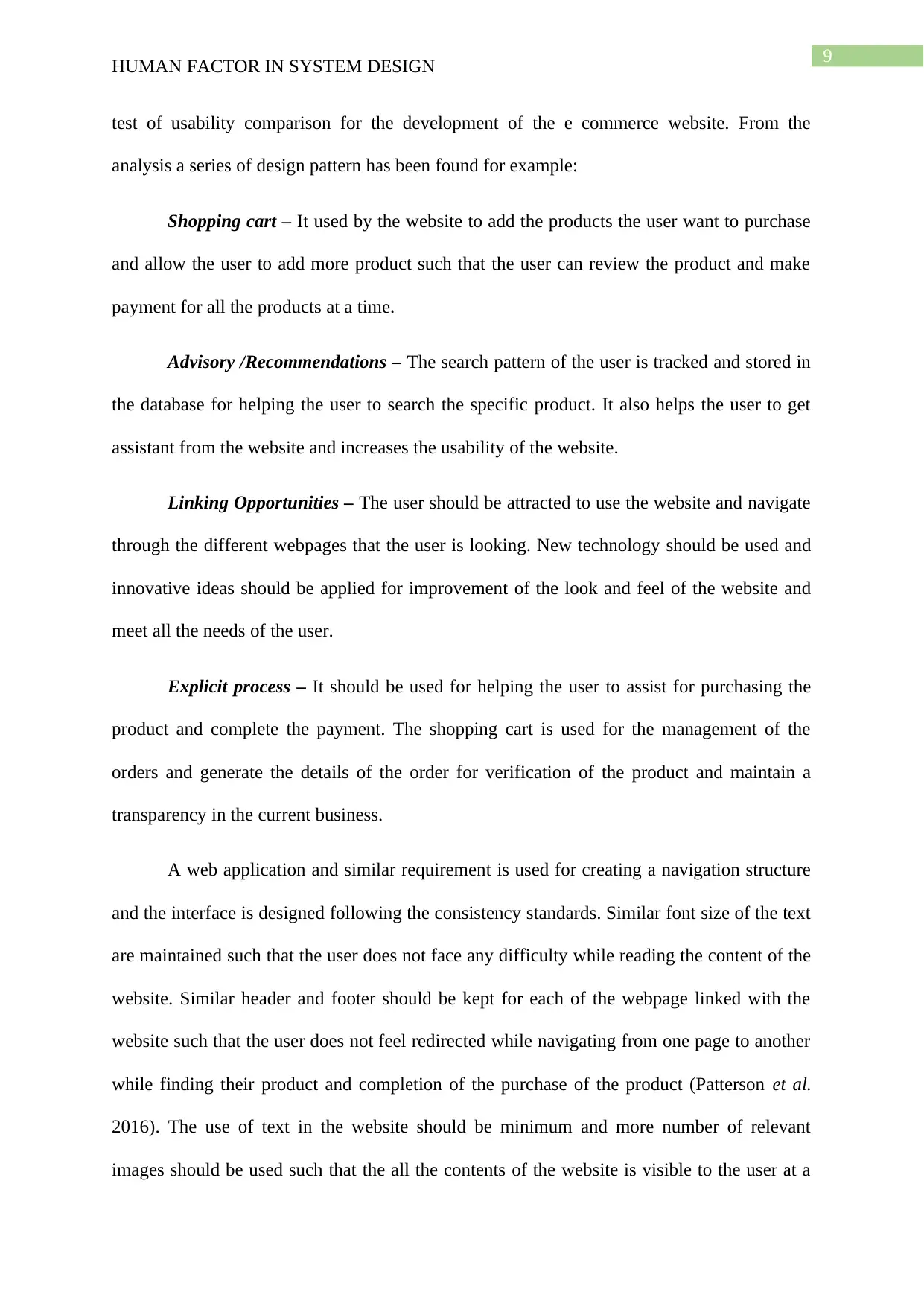
9
HUMAN FACTOR IN SYSTEM DESIGN
test of usability comparison for the development of the e commerce website. From the
analysis a series of design pattern has been found for example:
Shopping cart – It used by the website to add the products the user want to purchase
and allow the user to add more product such that the user can review the product and make
payment for all the products at a time.
Advisory /Recommendations – The search pattern of the user is tracked and stored in
the database for helping the user to search the specific product. It also helps the user to get
assistant from the website and increases the usability of the website.
Linking Opportunities – The user should be attracted to use the website and navigate
through the different webpages that the user is looking. New technology should be used and
innovative ideas should be applied for improvement of the look and feel of the website and
meet all the needs of the user.
Explicit process – It should be used for helping the user to assist for purchasing the
product and complete the payment. The shopping cart is used for the management of the
orders and generate the details of the order for verification of the product and maintain a
transparency in the current business.
A web application and similar requirement is used for creating a navigation structure
and the interface is designed following the consistency standards. Similar font size of the text
are maintained such that the user does not face any difficulty while reading the content of the
website. Similar header and footer should be kept for each of the webpage linked with the
website such that the user does not feel redirected while navigating from one page to another
while finding their product and completion of the purchase of the product (Patterson et al.
2016). The use of text in the website should be minimum and more number of relevant
images should be used such that the all the contents of the website is visible to the user at a
HUMAN FACTOR IN SYSTEM DESIGN
test of usability comparison for the development of the e commerce website. From the
analysis a series of design pattern has been found for example:
Shopping cart – It used by the website to add the products the user want to purchase
and allow the user to add more product such that the user can review the product and make
payment for all the products at a time.
Advisory /Recommendations – The search pattern of the user is tracked and stored in
the database for helping the user to search the specific product. It also helps the user to get
assistant from the website and increases the usability of the website.
Linking Opportunities – The user should be attracted to use the website and navigate
through the different webpages that the user is looking. New technology should be used and
innovative ideas should be applied for improvement of the look and feel of the website and
meet all the needs of the user.
Explicit process – It should be used for helping the user to assist for purchasing the
product and complete the payment. The shopping cart is used for the management of the
orders and generate the details of the order for verification of the product and maintain a
transparency in the current business.
A web application and similar requirement is used for creating a navigation structure
and the interface is designed following the consistency standards. Similar font size of the text
are maintained such that the user does not face any difficulty while reading the content of the
website. Similar header and footer should be kept for each of the webpage linked with the
website such that the user does not feel redirected while navigating from one page to another
while finding their product and completion of the purchase of the product (Patterson et al.
2016). The use of text in the website should be minimum and more number of relevant
images should be used such that the all the contents of the website is visible to the user at a
Paraphrase This Document
Need a fresh take? Get an instant paraphrase of this document with our AI Paraphraser
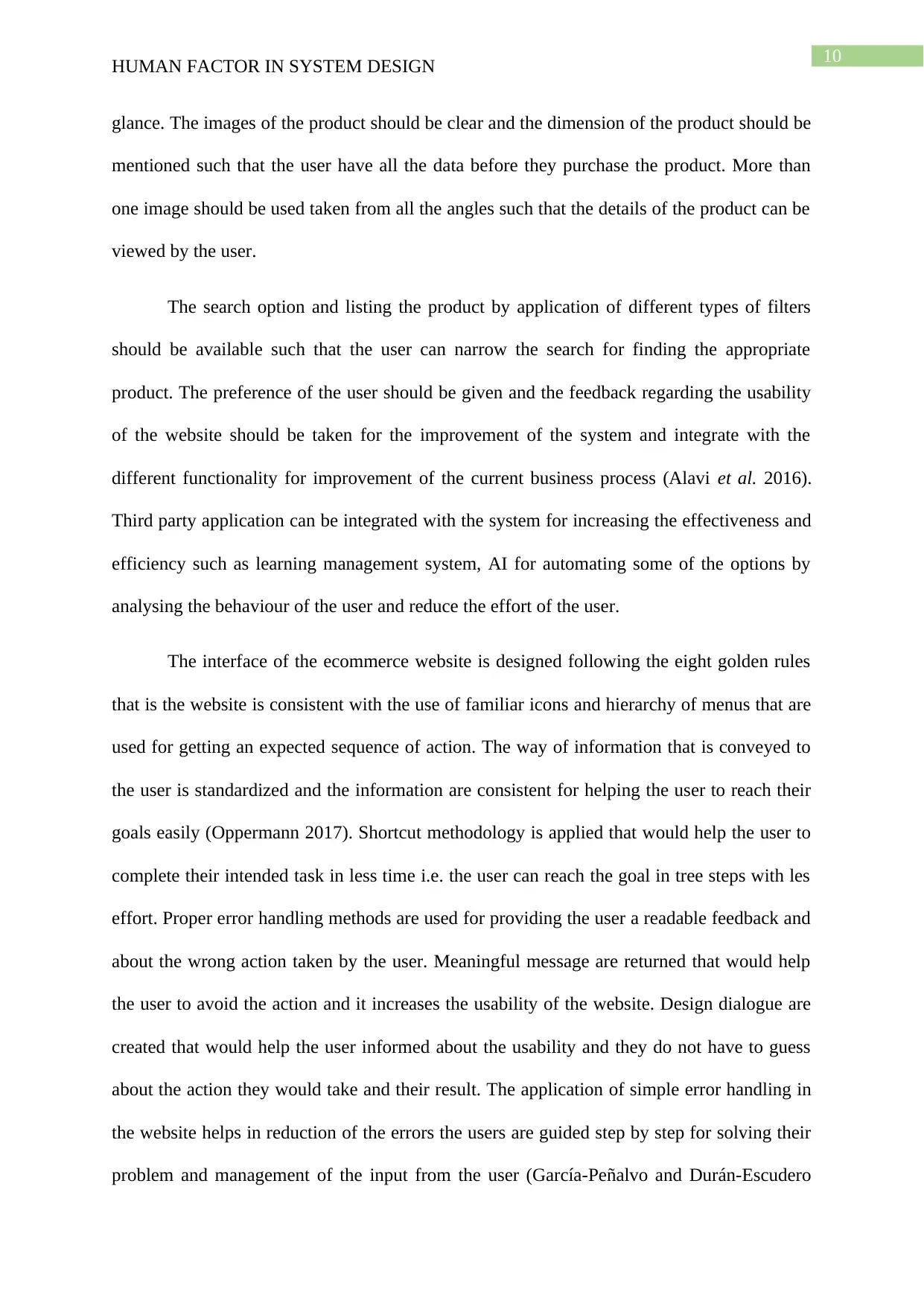
10
HUMAN FACTOR IN SYSTEM DESIGN
glance. The images of the product should be clear and the dimension of the product should be
mentioned such that the user have all the data before they purchase the product. More than
one image should be used taken from all the angles such that the details of the product can be
viewed by the user.
The search option and listing the product by application of different types of filters
should be available such that the user can narrow the search for finding the appropriate
product. The preference of the user should be given and the feedback regarding the usability
of the website should be taken for the improvement of the system and integrate with the
different functionality for improvement of the current business process (Alavi et al. 2016).
Third party application can be integrated with the system for increasing the effectiveness and
efficiency such as learning management system, AI for automating some of the options by
analysing the behaviour of the user and reduce the effort of the user.
The interface of the ecommerce website is designed following the eight golden rules
that is the website is consistent with the use of familiar icons and hierarchy of menus that are
used for getting an expected sequence of action. The way of information that is conveyed to
the user is standardized and the information are consistent for helping the user to reach their
goals easily (Oppermann 2017). Shortcut methodology is applied that would help the user to
complete their intended task in less time i.e. the user can reach the goal in tree steps with les
effort. Proper error handling methods are used for providing the user a readable feedback and
about the wrong action taken by the user. Meaningful message are returned that would help
the user to avoid the action and it increases the usability of the website. Design dialogue are
created that would help the user informed about the usability and they do not have to guess
about the action they would take and their result. The application of simple error handling in
the website helps in reduction of the errors the users are guided step by step for solving their
problem and management of the input from the user (García-Peñalvo and Durán-Escudero
HUMAN FACTOR IN SYSTEM DESIGN
glance. The images of the product should be clear and the dimension of the product should be
mentioned such that the user have all the data before they purchase the product. More than
one image should be used taken from all the angles such that the details of the product can be
viewed by the user.
The search option and listing the product by application of different types of filters
should be available such that the user can narrow the search for finding the appropriate
product. The preference of the user should be given and the feedback regarding the usability
of the website should be taken for the improvement of the system and integrate with the
different functionality for improvement of the current business process (Alavi et al. 2016).
Third party application can be integrated with the system for increasing the effectiveness and
efficiency such as learning management system, AI for automating some of the options by
analysing the behaviour of the user and reduce the effort of the user.
The interface of the ecommerce website is designed following the eight golden rules
that is the website is consistent with the use of familiar icons and hierarchy of menus that are
used for getting an expected sequence of action. The way of information that is conveyed to
the user is standardized and the information are consistent for helping the user to reach their
goals easily (Oppermann 2017). Shortcut methodology is applied that would help the user to
complete their intended task in less time i.e. the user can reach the goal in tree steps with les
effort. Proper error handling methods are used for providing the user a readable feedback and
about the wrong action taken by the user. Meaningful message are returned that would help
the user to avoid the action and it increases the usability of the website. Design dialogue are
created that would help the user informed about the usability and they do not have to guess
about the action they would take and their result. The application of simple error handling in
the website helps in reduction of the errors the users are guided step by step for solving their
problem and management of the input from the user (García-Peñalvo and Durán-Escudero
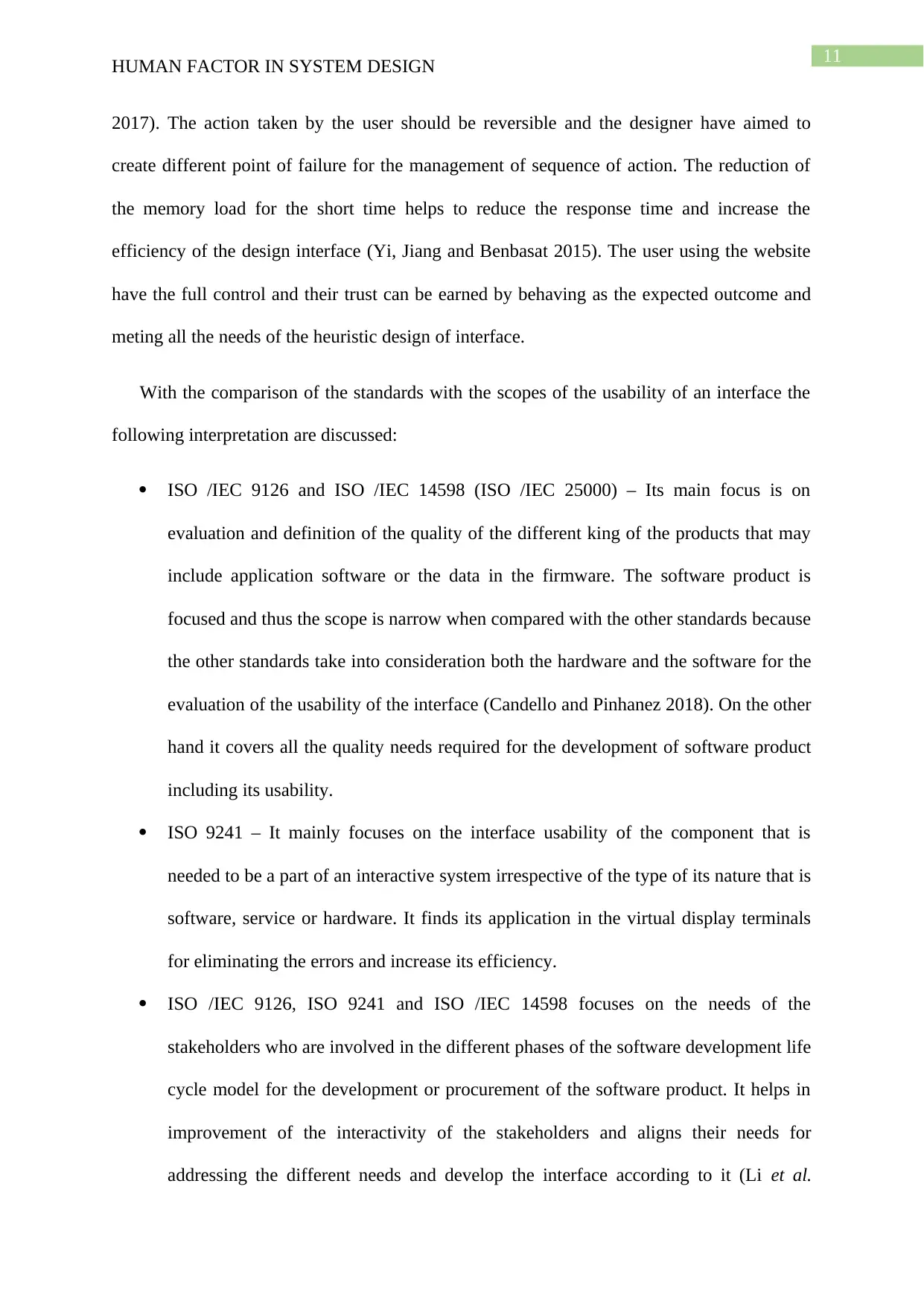
11
HUMAN FACTOR IN SYSTEM DESIGN
2017). The action taken by the user should be reversible and the designer have aimed to
create different point of failure for the management of sequence of action. The reduction of
the memory load for the short time helps to reduce the response time and increase the
efficiency of the design interface (Yi, Jiang and Benbasat 2015). The user using the website
have the full control and their trust can be earned by behaving as the expected outcome and
meting all the needs of the heuristic design of interface.
With the comparison of the standards with the scopes of the usability of an interface the
following interpretation are discussed:
ISO /IEC 9126 and ISO /IEC 14598 (ISO /IEC 25000) – Its main focus is on
evaluation and definition of the quality of the different king of the products that may
include application software or the data in the firmware. The software product is
focused and thus the scope is narrow when compared with the other standards because
the other standards take into consideration both the hardware and the software for the
evaluation of the usability of the interface (Candello and Pinhanez 2018). On the other
hand it covers all the quality needs required for the development of software product
including its usability.
ISO 9241 – It mainly focuses on the interface usability of the component that is
needed to be a part of an interactive system irrespective of the type of its nature that is
software, service or hardware. It finds its application in the virtual display terminals
for eliminating the errors and increase its efficiency.
ISO /IEC 9126, ISO 9241 and ISO /IEC 14598 focuses on the needs of the
stakeholders who are involved in the different phases of the software development life
cycle model for the development or procurement of the software product. It helps in
improvement of the interactivity of the stakeholders and aligns their needs for
addressing the different needs and develop the interface according to it (Li et al.
HUMAN FACTOR IN SYSTEM DESIGN
2017). The action taken by the user should be reversible and the designer have aimed to
create different point of failure for the management of sequence of action. The reduction of
the memory load for the short time helps to reduce the response time and increase the
efficiency of the design interface (Yi, Jiang and Benbasat 2015). The user using the website
have the full control and their trust can be earned by behaving as the expected outcome and
meting all the needs of the heuristic design of interface.
With the comparison of the standards with the scopes of the usability of an interface the
following interpretation are discussed:
ISO /IEC 9126 and ISO /IEC 14598 (ISO /IEC 25000) – Its main focus is on
evaluation and definition of the quality of the different king of the products that may
include application software or the data in the firmware. The software product is
focused and thus the scope is narrow when compared with the other standards because
the other standards take into consideration both the hardware and the software for the
evaluation of the usability of the interface (Candello and Pinhanez 2018). On the other
hand it covers all the quality needs required for the development of software product
including its usability.
ISO 9241 – It mainly focuses on the interface usability of the component that is
needed to be a part of an interactive system irrespective of the type of its nature that is
software, service or hardware. It finds its application in the virtual display terminals
for eliminating the errors and increase its efficiency.
ISO /IEC 9126, ISO 9241 and ISO /IEC 14598 focuses on the needs of the
stakeholders who are involved in the different phases of the software development life
cycle model for the development or procurement of the software product. It helps in
improvement of the interactivity of the stakeholders and aligns their needs for
addressing the different needs and develop the interface according to it (Li et al.
⊘ This is a preview!⊘
Do you want full access?
Subscribe today to unlock all pages.

Trusted by 1+ million students worldwide
1 out of 21
Related Documents
Your All-in-One AI-Powered Toolkit for Academic Success.
+13062052269
info@desklib.com
Available 24*7 on WhatsApp / Email
![[object Object]](/_next/static/media/star-bottom.7253800d.svg)
Unlock your academic potential
Copyright © 2020–2025 A2Z Services. All Rights Reserved. Developed and managed by ZUCOL.





